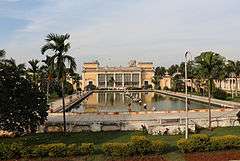Chowmahalla Palace
| Chowmahalla Palace bhawan | |
|---|---|
 | |
| General information | |
| Type | Royal Palace |
| Location | Hyderabad, Telangana, India |
| Completed | 1880s |
Chowmahalla Palace or Chowmahallatuu (4 Palaces), is a palace of the Nizams of Hyderabad state. It was the seat of the Asaf Jahi dynasty and was the official residence of the Nizams of Hyderabad while they ruled their state. The palace remains the property of Barkat Ali Khan Mukarram Jah, heir of the Nizams.
In Urdu, Hindi Char means four, and even in Persian, Chahar means four and in Urdu and Hindi Mahal means palaces, hence the name Chowmahalla/four palaces.
The palace is located in the old city in Hyderabad near the Charminar
All ceremonial functions including the accession of the Nizams and receptions for the Governor-General were held at this palace.
The prestigious UNESCO Asia Pacific Merit award for cultural heritage conservation was presented to Chowmahalla Palace on 15 March 2010. UNESCO representative Takahiko Makino formally handed over the plaque and certificate to Princess Esra, former wife and GPA holder of Prince Mukarram Jah Bahadur.[1][2]
History
While Salabat Jung initiated its construction in 1750,[3] it was completed by the period of Afzal ad-Dawlah, Asaf Jah V between 1857 and 1869.
The palace is unique for its style and elegance. Building of the palace began in the late 18th century and over the decades a synthesis of many architectural styles and influences emerged. The palace consists of two courtyards as well as the grand Khilwat (the Dharbar Hall), fountains and gardens. The palace originally covered 45 acres (180,000 m2), but only 12 acres (49,000 m2) remain today.
Southern courtyard
This is the oldest part of the palace, and has four palaces Afzal Mahal, Mahtab Mahal, Tahniyat Mahal and Aftab Mahal. It was built in the neo-classical style.
Northern courtyard
This part has Bara Imam, a long corridor of rooms on the east side facing the central fountain and pool that once housed the administrative wing and Shishe-Alat, meaning mirror image.
It has Mughal domes and arches and many Persian elements like the ornate stucco work that adorn the Khilwat Mubarak. These were characteristic of buildings built in Hyderabad at the time.
Opposite the Bara Imam is a building that is its shishe or mirror image. The rooms were once used as guest rooms for officials accompanying visiting dignitaries.
Khilwat Mubarak

This is heart of Chowmahalla Palace. It is held in high esteem by the people of Hyderabad, as it was the seat of the Asaf Jahi dynasty. The grand pillared Durbar Hall has a pure marble platform on which the Takht-e-Nishan or the royal seat was laid. Here the Nizams held their durbar and other religious and symbolic ceremonies. The 19 spectacular Chandeliers of Belgian crystal recently reinstalled to recreate the lost splendor of this regal hall.
Clock Tower
The clock above the main gate to Chowmahalla Palace is affectionately called Khilwat Clock. It has been ticking away for around 250 years. An expert family of clock repairers winds the mechanical clock every week.
Council Hall
This building housed a rare collection of manuscripts and priceless books.The Nizam often met important officials and dignitaries here. Today it is a venue for temporary exhibitions from the treasures of the Chowmahalla Palace Collection of the bygone era.
Roshan Bangla

The sixth Nizam is believed to have lived here and the building was named after his mother Roshan Begum.
The present Nizam (Barkat Ali Khan Mukarram Jah) and his family decided to restore the Chowmahalla Palace and open it to the public in January 2005. It took over 5 years to document and restore the palaces of the first courtyard to its former glory.

See also
- Nizam of Hyderabad
- Purani Haveli
- Falaknuma Palace
- King Kothi
- Chiran Palace
- Jewels of the Nizams
- Jacob Diamond
- Basheer Bagh Palace
References
- ↑
- ↑ "Archived copy". Archived from the original on 30 August 2011. Retrieved 2011-06-06.
- ↑ forgeten. Retrieved 4 April 2013.
External links
| Wikimedia Commons has media related to Chowmahalla Palace. |
- Chowmahalla Palace Official Website
- The lost world: article by historian William Dalrymple about the last Nizam of Hyderabad and the restoration of Chowmahalla Palace
- Travel guide issued by Authority: The Administrator, H.E.H The Nizam's Private Estate